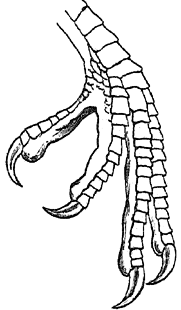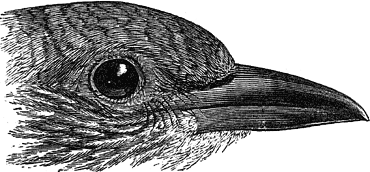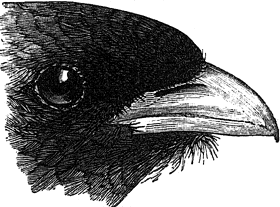|
Page 36 | prev page next page | ||||||
|
Order V. ANISODACTYLI Scarcely any two modern ornithologists are agreed as to the affinities between the Rollers and several other groups of Picarian birds, especially the Kingfishers, Bee-eaters, Hornbills, Hoopoes, Swifts, and Nightjars*‘. All these, except the Hoopoes, have a peculiar and variable arrangement of the deep plantar tendons (Garrod, P.Z.S. 1875, p.344). The two tendons coalesce more or less completely either before their subdivision to supply the different digits or below the point at which a slip leaves the flexor perforans digitorum to supply the hallux. In other respects, such as the characters of the palate and sternum, the form of the dorsal feather-tracts, presence or absence of caeca and the nature of the oil-gland, whether nude or tufted, there is much variation, and the majority of the families mentioned differ from each other quite as much as the Passeres and Eurylaemi do. It appears very doubtful whether the Swifts have any affinity to the other groups, and the Caprimulgidae and Podargidae are also isolated. In adopting Gadow’s arrangement and leaving the Coraciadae or Rollers, Meropidae or Bee-eaters, Alcedinidae or Kingfishers, Bucerotidae or Hornbills, and Upupidae or Hoopoes in one order, I am very largely influenced by a desire to avoid increasing the number of ordinal groups. The Anisodactyli have a desmognathous palate; basipterygoid processes are rudimentary or absent. Sternal characters vary. There is no ambiens muscle. A hallux is always present, and there are almost constantly three anterior toes, more or less joined together at the base. All the species lay white eggs in a hole, either in a tree or in the ground, and the young are hatched naked. The sexes are alike as a rule, but when they differ in plumage the young resemble adults of the same sex.
There are five Indian suborders, thus distinguished:
a. Oil-gland nude; caeca present; 4 notches behind sternum. The South-American Motmots and W.-Indian Todies also belong here. Suborder CORACIAE Caeca present. Oil-gland nude. Sternum with four notches on the posterior margin, and the manubrium sterni consists of the outer process (spina externa) only and is long and not distinctly forked. Both carotids are present. The spinal feather-tract well defined on the neck, but forked on the upper back, to leave a dorsal apterium or featherless space. 14 cervical vertebrae. The plantar tendons blend completely before subdividing at all. A single family.
Fig. 28 - left foot of C. indica Bill corvine in shape, the upper mandible notched beneath near the end, culmen rounded. Outer united to the middle toe at the extreme base, inner toe united by its basal joint. Nostrils at the base of the mandible. Primaries 10; tail-feathers 12. Sexes alike. This family is found in tropical and temperate regions of the Old World. Two genera are Indian.
Key to the Genera Bill rather long, compressed, culmen slightly curved, nostrils elongate; gape wide, with strong rictal bristles. To this genus belong three Indian and Burmese birds, of which one is migratory and only occurs in north-western India. Species are found throughout Africa, Europe and Central Asia, and in Celebes.
Key to the Species
Fig. 29 - head of C. indica Coloration: Narrow forehead and chin pale brownish rufous; crown and nape bluish green, brighter, and bluer above the eyes; hind neck and sides of neck deep vinous; back, scapulars, and tertiaries dull greenish brown; small coverts near the edge of the wing deep purplish blue, other coverts light greyish green, except the outer large primary and the tips of the other greater coverts, which, with the edge of the wing, all under wing-coverts, and axillaries, are pale blue; quills deep purplish blue; a broad light blue band across the terminal half of the primaries, the tips dark, with the outer webs greenish. Rump light greenish blue, mixed with deep blue; upper tail-coverts chiefly deep blue; middle tail- feathers dull dark green, basal part near shaft blue; other tail-feathers deep blue, crossed near the tip by a broad pale blue band, wider on the outer feathers. Sides of head and throat purplish lilac, with broad whitish shaft-stripes; breast vinous rufous, with less marked white shaft-stripes; abdomen and lower tail-coverts pale blue like wing-lining. Bill blackish brown; iris greyish brown; eyelid and naked skin round the eye pale gamboge; feet brownish yellow (Butler). Size: Length about 13; tail 5; wing 7.3; tarsus 1; bill from gape 1.7 Distribution: Throughout India and Ceylon in suitable localities, not ascending the Himalayas nor the hills of the peninsula in general, and wanting both in thick jungle and in open treeless deserts. East of Calcutta this species is replaced by C. affinis, but to the westward, though it becomes rare in the northern Punjab and wanting in Kashmir, it is found sparingly throughout Baluchistan, all round the shores of the Persian Gulf to Muscat, and stragglers have even been obtained in Asia Minor and on the Bosphorus. Habits: This is one of the typical Indian birds familiar to all inhabitants of the country. It is commonly found in cultivated tracts on trees about villages, and in thin tree and bush jungle. It is, as Blyth remarks, one of the birds that perch on telegraph wires. Jerdon says: “It generally takes its perch on the top or outermost branch of some high tree, and on spying an insect on the ground, which it can do at a very great distance, it flies direct to the spot, seizes it, and returns to its perch to swallow it. A favourite perch of the Roller is a bowrie pole, or some leafless tree, whence it can see well all round, also old buildings, a haystack or other elevated spot, sometimes a low bush or a heap of earth or of stones. When seated, it puffs out the feathers of its head and neck. I have on several occasions seen one pursue an insect in the air for some distance, and when the winged termites issue from their nest after rain, the Roller, like almost every other bird, catches them on the wing.” (The Roller is also conspicuous at jungle fires, hunting for insects, and perhaps for lizards, in company with kites, crows, and king-crows.) “It flies in general with a slow but continued flapping of its wings, not unlike the crow, though more buoyant; but it has the habit of occasionally making sudden darts in the air in all directions. Its food is chiefly large insects, grasshoppers, crickets, Mantidae, and even beetles, occasionally a small fieldmouse or shrew.” “The Roller has a very harsh grating cry or scream, which it always utters when disturbed and often at other times also.” “The Nilkant is sacred to Siva, who assumed its form, and at the feast of the Dusserah at Nagpur, one or more used to be liberated by the Rajah.” The liberation of this bird takes place during other Hindu ceremonies in various parts of India. In most parts of India the Roller is resident, but it leaves the open Bombay Deccan for better wooded tracts, according to several observers, during the breeding-season. It breeds from March in upper India, from January in Ceylon, till June or July, but chiefly in March, April, and May, making use of a hole in a tree, or sometimes in an old wall or the roof of a house. The nest is generally lined with a varying amount of vegetable fibre, grass, a few feathers or some old rags, but the lining is often omitted altogether. The eggs are a broad oval, of the purest china-white and very glossy, usually 4 in number (occasionally 5); they measure about 1.3 by 1.06.
Coloration: Head above pale dull green, passing into bright pale verditer-blue on the broad and long supercilia; back, scapulars, and tertiaries olive-brown; smaller and median wing-coverts dark blue, greater secondary-coverts bluish green, greater primary coverts pale blue, quills deep blue with a bar of pale blue across the terminal half of the primaries; rump deep blue; upper tail coverts pale blue; middle tail-feathers dusky green, the others deep blue at the base, light blue on the terminal half, slightly tipped with dusky; sides of head, chin, and throat purplish blue, the throat-feathers with shining blue shaft-stripes; breast vinaceous brown, passing on lower abdomen into dark, then into pale blue; wing-lining deep purplish blue throughout. Bill dark brownish black, mouth yellow; edges of the eyelids, lores, and skin at the back of the eye yellowish orange; iris brown; legs yellowish brown. Size: Length about 13; tail 4.75; wing 7.5; tarsus 1; bill from gape 1.7. Distribution: Throughout Burma except in the extreme south of Tenasserim, also in Siam and Cochin China, and through the countries north of Burma to the foot of the Himalayas in Assam. This species is found in Tipperah, Cachar, and Sylhet; but north of the head of the Bay of Bengal, from Calcutta to Tipperah and from eastern Nepal to Assam, over a belt 150 or 200 miles broad between E. long. 88° and 91°, intermediate forms between C. indica and C. affinis prevail. These I regard as hybrids, as each of the two forms is found constant in character throughout a wide area. Habits: Similar to those of C. indica. This bird breeds in March, April, and May, and lays 4 or 5 white eggs, measuring about 1.37 by 1.09.
Coloration: Narrow forehead and chin hoary white; head, neck, and lower parts, including the wing-lining, pale blue with a greenish tinge; head above and nape brighter, throat with bright longitudinal streaks; back, scapulars, and tertiaries light brownish rufous; wing-coverts pale blue, smaller coverts along the forearm deep blue, greater primary-coverts very pale blue, tipped dusky; quills black, some of the primaries with a greenish gloss on the outer web outside, inner webs of all deep blue on the under surface; rump deep purplish blue, more or less mixed with light blue and passing into light greenish blue on the upper tail-coverts; middle pair of tail-feathers dull bronze-green, brighter along the shafts, about the basal two-thirds of outer webs of other tail- feathers dull green, of inner webs black, terminal portion of both webs, broader on the outer feathers, pale blue, extreme tips of outer pair blackish. Young birds are duller and browner. Bill black; iris dark brown; feet yellowish brown. Size: Length about 12; tail 5; wing 7.8; tarsus 0.9; bill from gape 1.6 Distribution: A migratory bird, wintering in Africa, passing the summer and breeding in Europe and central Asia (Persia, Turkestan). It also breeds commonly in Kashmir and the Peshawur valley, and is found during migration in Sind and throughout the Punjab. Specimens have been collected as far east as Dhulia in Khandesh, Ahmedabad, the Satpura hills, Ajmere, Mussooree, and Garhwál. Habits: Very similar to those of C. indica, but the present species is more often seen away from trees. It has the same peculiar flight, the same habit of tumbling about in the air (whence the name of Roller), and a similar harsh voice, and it lives on insects in the same way. It nidificates sometimes in holes or hollows in trees, often in cliffs or sandy banks, or mud walls, occasionally in ruins, and lays from May to July 4 or 5 or rarely 6 white, glossy, long oval eggs, measuring on an average 1.52 by 1.1. Mr. Blyth states that he saw a skin from Kashmir showing intermixture of this species with C. indica. Genus EURYSTOMUS, Vieill., 1816 Bill short and broad; width of the gape about equal to the length of the culmen, the terminal part compressed and the upper mandible hooked; no rictal bristles. A single species is Indian; other species occur in Madagascar and tropical Africa, China, the Malay Archipelago, and Australia.
Fig. 30 - head of E. orientalis Coloration: Head and neck above and at the sides blackish brown, more or less tinged with green; back much greener, passing into dark bluish green on the rump and upper tail-coverts, and on the scapulars and tertiaries, and into brighter greenish blue on the wing-coverts; primary-coverts deep blue, quills black, deep blue on the outer webs, the outer primaries crossed near the base by a broad pale blue band; tail-feathers black, the outer webs above and the inner below washed for a varying distance from the base with deep blue; throat deep blue, with bright blue shaft-stripes; remainder of lower surface greenish blue, darker on the breast. Bill, legs, and feet deep vermilion, tip of bill black; iris dark brown; gape yellowish (Oates). The young is duller in colour, wants the bright blue streaks on the throat, and has a black bill. Size: Length about 12; tail 4; wing 7.5; tarsus 0.8; bill from gape 1.7. Ceylon and Travancore birds are deeper in colour, the head very dark, almost black, and the underparts bluer. These form a well-marked race or subspecies, E. laetior of Sharpe. Sharpe also distinguishes the Himalayan and Chinese and some Burmese and Malay birds under the name E. calonyx, on account of the blue on the outer webs of the tail-feathers extending to the terminal half of the feathers and of the outer webs of the secondaries being washed with blue; and he regards E. calonyx as a migratory and E. orientalis as a non-migratory form; but I find considerable variation, and doubt whether two forms can be distinguished. Distribution: Along the base of the Himalayas as far west as Kumaon up to about 3000 feet and from lower Bengal, Cachar, and Assam locally throughout the Burmese countries to China and Manchuria, Siam and Cochin China, and down the Malay peninsula to Sumatra, Java, Borneo, and the Philippines; common in the Andamans. Also found in southern India near the Malabar coast as far north as the Wynaad, and in Ceylon, where this bird is rare. Habits: A forest bird, resident or locally migratory, haunting high trees and usually perching on a dead tree or branch, some times on a bamboo, whence it flies down to capture insects. It is somewhat crepuscular in its habits and is generally silent; its call is a monosyllabic deep-toned whistle, but occasionally in the breeding-season it makes a chattering noise. In confinement it eats plantains. It breeds in March and April, in holes in branches of trees, as a rule at a considerable height from the ground, and lays on the bare wood usually 3 white eggs, measuring about 1.38 by 1.15. |
| ||||||
| prev page :: next page | |||||||
 birding.in | |
| ANISODACTYLI - suborder Coraciae - Rollers
|
| |||||||||||||||||||||


